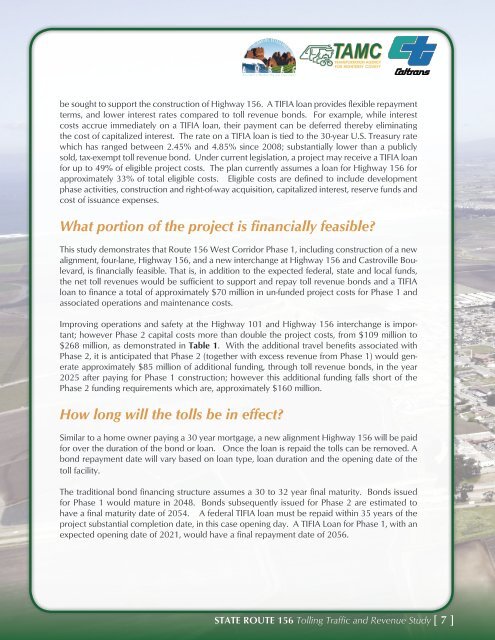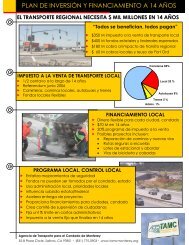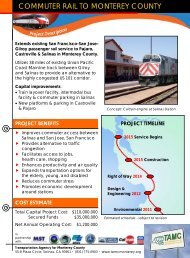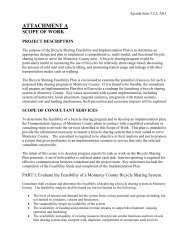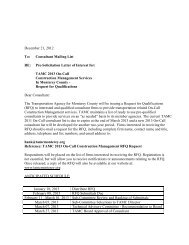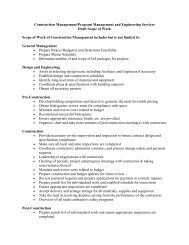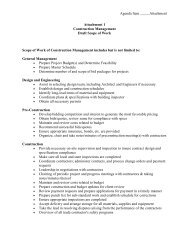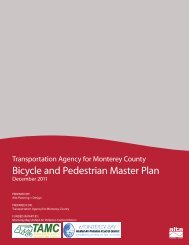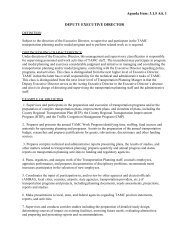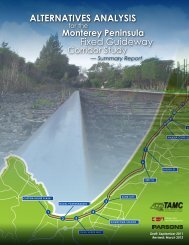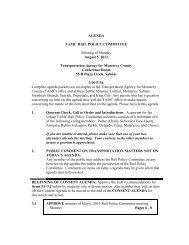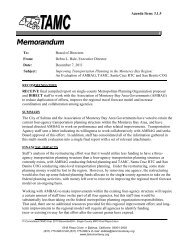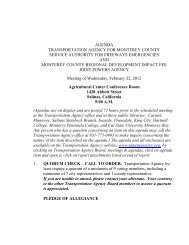156 Toll Road Study and Appendices - Transportation Agency for ...
156 Toll Road Study and Appendices - Transportation Agency for ...
156 Toll Road Study and Appendices - Transportation Agency for ...
- No tags were found...
You also want an ePaper? Increase the reach of your titles
YUMPU automatically turns print PDFs into web optimized ePapers that Google loves.
e sought to support the construction of Highway <strong>156</strong>. A TIFIA loan provides flexible repaymentterms, <strong>and</strong> lower interest rates compared to toll revenue bonds. For example, while interestcosts accrue immediately on a TIFIA loan, their payment can be deferred thereby eliminatingthe cost of capitalized interest. The rate on a TIFIA loan is tied to the 30-year U.S. Treasury ratewhich has ranged between 2.45% <strong>and</strong> 4.85% since 2008; substantially lower than a publiclysold, tax-exempt toll revenue bond. Under current legislation, a project may receive a TIFIA loan<strong>for</strong> up to 49% of eligible project costs. The plan currently assumes a loan <strong>for</strong> Highway <strong>156</strong> <strong>for</strong>approximately 33% of total eligible costs. Eligible costs are defined to include developmentphase activities, construction <strong>and</strong> right-of-way acquisition, capitalized interest, reserve funds <strong>and</strong>cost of issuance expenses.What portion of the project is financially feasible?This study demonstrates that Route <strong>156</strong> West Corridor Phase 1, including construction of a newalignment, four-lane, Highway <strong>156</strong>, <strong>and</strong> a new interchange at Highway <strong>156</strong> <strong>and</strong> Castroville Boulevard,is financially feasible. That is, in addition to the expected federal, state <strong>and</strong> local funds,the net toll revenues would be sufficient to support <strong>and</strong> repay toll revenue bonds <strong>and</strong> a TIFIAloan to finance a total of approximately $70 million in un-funded project costs <strong>for</strong> Phase 1 <strong>and</strong>associated operations <strong>and</strong> maintenance costs.Improving operations <strong>and</strong> safety at the Highway 101 <strong>and</strong> Highway <strong>156</strong> interchange is important;however Phase 2 capital costs more than double the project costs, from $109 million to$268 million, as demonstrated in Table 1. With the additional travel benefits associated withPhase 2, it is anticipated that Phase 2 (together with excess revenue from Phase 1) would generateapproximately $85 million of additional funding, through toll revenue bonds, in the year2025 after paying <strong>for</strong> Phase 1 construction; however this additional funding falls short of thePhase 2 funding requirements which are, approximately $160 million.How long will the tolls be in effect?Similar to a home owner paying a 30 year mortgage, a new alignment Highway <strong>156</strong> will be paid<strong>for</strong> over the duration of the bond or loan. Once the loan is repaid the tolls can be removed. Abond repayment date will vary based on loan type, loan duration <strong>and</strong> the opening date of thetoll facility.The traditional bond financing structure assumes a 30 to 32 year final maturity. Bonds issued<strong>for</strong> Phase 1 would mature in 2048. Bonds subsequently issued <strong>for</strong> Phase 2 are estimated tohave a final maturity date of 2054. A federal TIFIA loan must be repaid within 35 years of theproject substantial completion date, in this case opening day. A TIFIA Loan <strong>for</strong> Phase 1, with anexpected opening date of 2021, would have a final repayment date of 2056.STATE ROUTE <strong>156</strong> <strong>Toll</strong>ing Traffic <strong>and</strong> Revenue <strong>Study</strong> [ 7 ]


